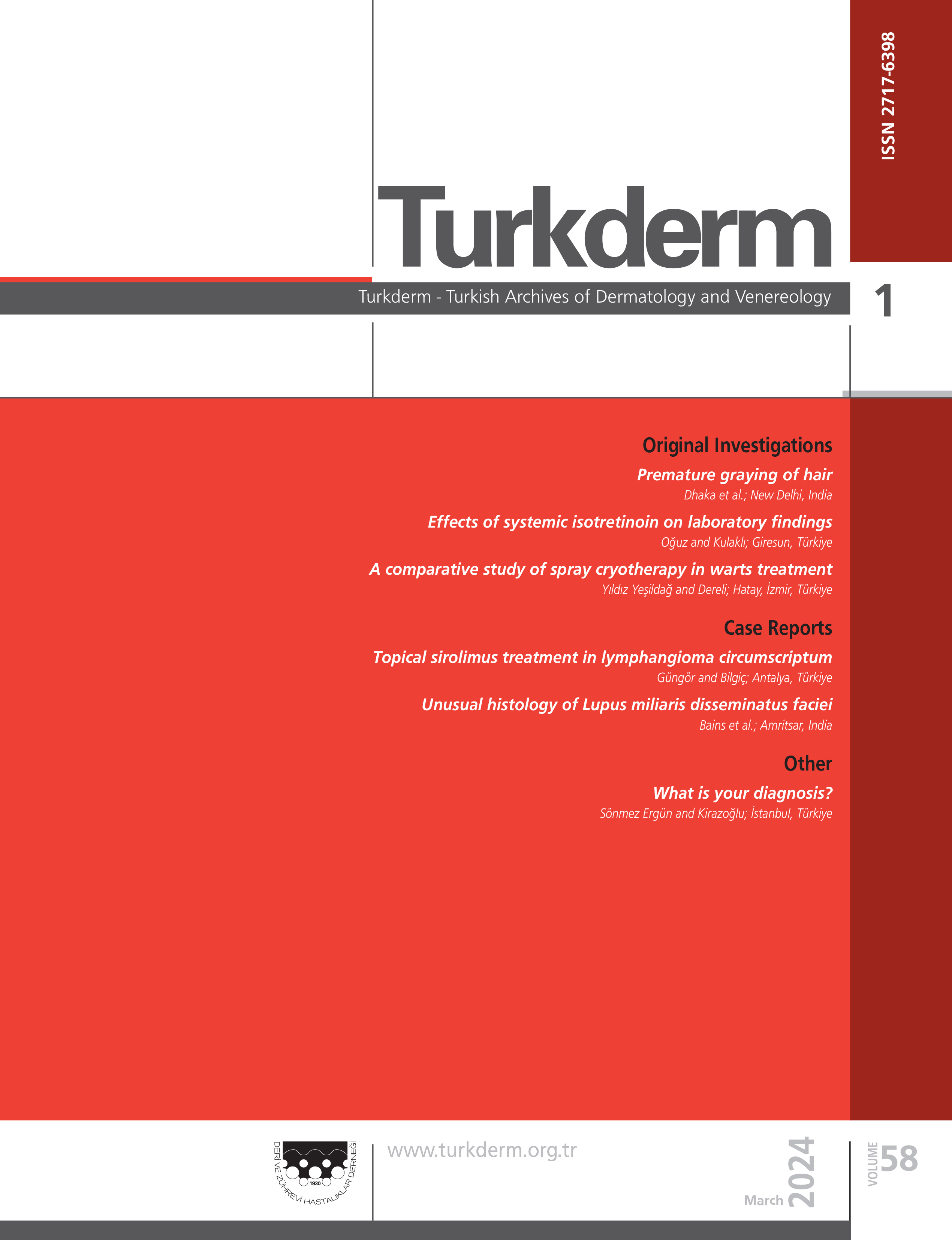Volume: 54 Issue: 3 - 2020
| 1. | Cover Pages I - XI |
| ORIGINAL INVESTIGATION | |
| 2. | The evaluation of ovarian reserve and menstrual irregularities in female patients treated with systemic isotretinoin Pelin Can, Emek Kocatürk, Veli Mihmanlı, Veysel Sucu, Ece Nur Degirmentepe, Utkan Kızıltaç doi: 10.4274/turkderm.galenos.2020.37974 Pages 79 - 84 Amaç: İzotretinoin, başta akne olmak üzere birçok dermatolojik hastalığın tedavisinde sıkça kullanılan ve birçok yan etkisi bilinen bir retinoiddir. Bu çalışma, aknesi olan kadın hastalarda izotretinoinin over rezervinin (OR) göstergeleri olan anti-Müllerian hormon (AMH), folikül stimüle edici hormon (FSH) ve total antral folikül sayılarına (TAFS) etkisini ve menstrüel düzensizliklerinin (MD) sıklığını araştırmayı amaçlamaktadır. Gereç ve Yöntem: Prospektif kontrollü olan bu çalışmaya üreme çağındaki 92 kadın dahil edildi. Çalışma, 32 sağlıklı kontrol, 29 düşük doz izotretinoin alan hasta (0,4-0,6 mg/kg/gün doz ortalaması: 0,56±0,06) ve 31 yüksek doz izotretinoin alan hastadan (0,7-1,1 mg/kg/gün doz ortalaması: 0,94±0,11) oluşmaktaydı. Tedavi grubunun serum AMH, FSH ve TAFS değerleri tedavi öncesi ve tedavinin altıncı ayı için, kontrol grubunun ise serum AMH ve FSH seviyeleri değerlendirilmiştir. Bulgular: Tedavi grubunun tedavinin altıncı ayındaki ortalama serum AMH değerleri tedavi öncesinden ve kontrol grubundan istatistiksel olarak düşük bulunmuştur (p<0,001, p=0,013). Ortalama serum FSH seviyelerinde artış ve TAFS seviyelerinde tedavi öncesine kıyasla düşüş saptanmıştır (p=0,912, p=0,824). On yedi hastada (%28,3) tedavi sırasında MD geliştiği saptandı. Sonuç: Ortalama total antral folikül sayılarındaki düşüş ve folikül stimüle edici hormon seviyelerindeki artış anlamlı olmasa da, anti-Müllerian hormon seviyelerinde anlamlı düşüşler, izotretinoinin OR üzerine negatif etkisinin bir sonucu olduğunu destekler niteliktedir Background and Design: Isotretinoin is a widely used retinoid for the treatment of many dermatological conditions notably in acne with many known side effects. This study aims to investigate the effects of isotretinoin on anti-Mullerian hormone (AMH), follicle stimulating hormone (FSH) and total antral follicle count (TAFC) as the indicators of ovarian reserve (OR) and also aims to investigate the frequency of menstrual irregularities (MI). Materials and Methods: Ninety-two reproductive women were included in this prospective controlled study. Study group is consisted of 32 healthy control, 29 low-dose (0.4-0.6 mg/kg/day mean: 0.56±0.06) and 31 high-dose isotretinoin received patients (0.7-1.1 mg/kg/day mean: 0.94±0.11). AMH, FSH and TAFC were evaluated before and at 6th month of treatment in the treatment group, while AMH and FSH levels were evaluated in the control group. Results: Mean AMH level of treatment group at the 6th month of treatment was significantly lower than the level prior to treatment and that of the control group (p<0.001, p=0.013). Mean FSH level was increased, and TAFC level was decreased compared to pretreatment period (p=0,912, p=0,824). Seventeen patients (28.3%) had MI during treatment. Conclusion: Although decrease in antral follicle numbers and increase in FSH levels were not significant, significant decreases in AMH levels may indicate the negative effect of isotretinoin on OR. |
| 3. | The correlation of age, gender and drug dose with side effects of isotretinoin in patients with acne vulgaris Dursun Türkmen doi: 10.4274/turkderm.galenos.2020.58815 Pages 85 - 89 Amaç: Akne vulgaris, pilosebase ünitenin kronik enflamatuvar bir hastalığıdır. Oral izotretinoin akne tedavisinde uzun yıllardır kullanılan en etkili tedavi ajanıdır. Çalışmamızda ilacın yan etkilerini tespit etmeyi ve bunların yaş, cinsiyet ve ilaç dozu ile bağlantısını araştırmayı amaçladık. Gereç ve Yöntem: Çalışmamızda, yaşları 14-34 arasında değişen, izotretinoin kullanan, 149 orta veya şiddetli akne vulgarisli hasta yer aldı. Sekiz hasta çeşitli sebeplerle tedaviye devam etmedi. Günlük izotretinoin dozu 0,5 mg/kgnin altında başlandı. Tüm hastalarda en az 120 mg/ kg kümülatif doz hedeflendi. Hastalar yan etkiler açısından aylık olarak değerlendirildi. Bulgular: Tedaviyi tamamlayan 141 hastanın 106sı (%75,2) kadın, 35i (%24,8) erkekti. Hastaların %100ünde keilitis, %66sında kseroderma, %44,7sinde fotofobi, %42,6sında hafif burun kanaması, %36,9unda göz kuruluğu görüldü. Bel ağrısı hastaların %41,1inde, kas ağrısı %29,1inde, eklem ağrısı %19,1inde ve baş ağrısı %13,5inde görüldü. Serum lipit düzeyleri hastaların %20,6sında, karaciğer enzim düzeyleri ise hastaların %7,8inde yüksekti. Kas ağrısı ve bel ağrısı kadın hastalarda daha yüksekti (sırasıyla; p=0,045, p=0,019). İlaç dozu 0,5 mg/ kg/günün üzerinde olan hastalarda kseroderma, kas ağrısı ve akne tetiklenmesi daha fazlaydı (sırasıyla; p=0,004, p=0,001, p=0,012). Yirmi yaşından büyük hastalarda kas ağrısı daha fazlaydı (p=0,003). Sonuç: İzotretinoin tedavisi uzun süreli bir tedavi olduğu için hasta uyumu önem arz etmektedir. Hangi hasta grubunda hangi yan etkilerin ne sıklıkta olduğunu iyi bilmek ve hastaları önceden bu konuda bilgilendirmek hastanın hekime olan güvenini arttıracaktır ve uyum problemini minimuma indirecektir. Background and Design: Acne vulgaris is a chronic inflammatory disease of pilosebaceous unit. Oral isotretinoin is the most effective agent that has been used for many years in acne treatment. The purpose of our study was to determine the side effects of the isotretinoin and to examine the correlation between these side effects, and age, gender and drug dose. Materials and Methods: One hundred forty nine patients with moderate or severe acne vulgaris (age between: 14-34 years) using isotretinoin were included. Eight patients discontinued treatment for various reasons. Daily isotretinoin dose was started as less than 0.5 mg/kg/day. A cumulative dose of at least 120 mg/kg was targeted in all patients. The patients were assessed in terms of side effects on a monthly basis. Results: Of the 141 patients who have completed the treatment, 106 (75.2%) were female and 35 (24.8%) were male. Cheilitis was seen in 100%, xeroderma in 66%, photophobia in 44.7%, mild epistaxis in 42.6%, and xerophthalmia in 36.9% of the patients. Lumbar pain was seen in 41.1%, myalgia in 29.1%, arthralgia in 19.1%, headache in 13.5% of the patients. Serum lipid levels increased in 20.6% of the patients, while liver enzyme levels increased in 7.8% of the patients. Myalgia and lumbar pain was more common in females (p=0.045, p=0.019, respectively). Patients who received higher than 0.5 mg/kg/day dose had more xerosis, myalgia and triggering acne complaints (p=0.004, p=0.001, p=0.012, respectively). Myalgia were found to be more common in patients who were older than 20 years old (p=0.003). Conclusion: Because the use of isotretinoin is a long-lasting treatment method, patient compliance is of paramount importance. Knowing how frequent side effects will occur in different patients groups and informing the patients beforehand will increase patients confidence towards to physician and minimize the compliance problems. |
| 4. | Relationship of cutaneous moisture, sebum and pH changes of healthy skin with menstrual cycle Nilgün Küçükaydoğan, Ekin Şavk, Meltem Uslu, Neslihan Sendur, Göksun Karaman, Serkan Demirkan doi: 10.4274/turkderm.galenos.2020.35683 Pages 90 - 95 Amaç: Derinin nem, sebum, pH özelliklerinin yaş, cinsiyet, gebelik ve menopoz gibi çeşitli fizyolojik süreçler ile değişimini araştırmaya yönelik çalışmalar sınırlı sayıdadır. Menstrüel siklus kadın vücudunda çeşitli organ ve sistemlerde değişikliklere neden olan fizyolojik bir proçestir. Bu çalışmada menstrüel siklus ile derinin nem, sebum ve pH değerlerindeki olası değişiklikler araştırılacaktır. Böylece, menstrüel siklusu yönlendiren hormonal değişikliklerin deride gözlemlenebilir etkilerinin olup olmadığının anlaşılması hedeflenmiştir. Gereç ve Yöntem: Çalışmamızda sağlıklı derinin nem, sebum ve pH değerlerinin menstrüel siklus ile ilişkisi, MPA-5 cihazı ile araştırılmıştır. Çalışmaya tıp fakültesi hastanesinde çalışan 21-45 yaş arasında, düzenli adet gören gönüllü 51 kadın olgu alındı. Ölçüm MPA-5 cihazı ile yapıldı. Bu çalışmada katılımcıların yüz derisi pH, nem ve sebum değerleri ardışık 2 menstrüel siklus boyunca, her siklusun başında (erken folliküler fazda), ortasında (geç folliküler fazda) ve sonunda (midluteal fazda) olmak üzere toplamda 6 kez ölçülmüştür. Nem ve pH için, yüz üzerinde belirlenen 5 farklı noktadan (glabella, her iki yanak zigomatik çıkıntılar, çenede mentum üzerinden ve burundan olmak üzere), sebum ölçümü ise glabelladan tek ölçüm olarak yapılmıştır. Bulgular: Yapılan ölçümlerden elde edilen veriler değerlendirildiğinde derinin nem, sebum ve pH değerlerinin menstrüel siklusun erken folliküler faz, geç folliküler faz ve midluteal faz ile uyumlu ölçümlerinde istatistiksel olarak anlamlı farklılık bulunmamıştır. Ayrıca kişilerin yaşları, vücut kitle indeksleri ve sigara kullanımı ile ortalama sebum, nem ve pH değerleri karşılaştırılmış, istatistiksel olarak anlamlı bir ilişki saptanmamıştır. Sonuç: Menstrüel siklustaki hormonal değişikliklerin, derinin nem, sebum ve pH değerlerinde herhangi bir değişikliğe neden olmaması, kişilerin muayenesinde, kişilere günlük bakım ürünü önerisinde bulunulmasında ve dermatopatolojik durumların saptanmasında menstrüel siklusun hangi döneminde olduğunun sonucu değiştirmeyeceğini göstermektedir. Yapılacak daha ayrıntılı ve uzun dönem çalışmalarla daha net sonuçlar elde edilebilir. Background and Design: Studies to investigate the change of skin moisture, sebum and pH properties in various physiological processes such as age, gender, pregnancy and menopause are limited. Menstrual cyle is a physiological process that causes changes in various organs and systems in the female body. In this study, possible changes in the moisture, sebum and PH values of the skin with menstrual cycle will be investigated. Thus, it is aimed to determine whether the hormonal changes that drive the menstrual cycle have observable effects on the skin. Materials and Methods: In our study, the relationship of skin moisture, sebum and pH values of healthy skin with the menstrual cycle was investigated with the MPA-5 device. Fifty-one volunteer women aged 21-45, working at the faculty of medicine, and having regular periods were included the study. The measurement was done with MPA-5 device. In this study, the skin PH, humidity and sebum values of the participants were measured 6 times in total during two consecutive menstrual cycles, at the beginning of each cycle (early follicular phase), middle (late follicular phase) and end (midluteal phase). Humidity and PH were measured from 5 different points on the face (glabella, bilateral zygomatic protrusions on both cheeks, mentum on the chin and nose) and sebum was measured from the glabella as a single measurement. Results: When the data obtained from the measurements were evaluated, there were no statistically significant differences in the moisture, sebum and PH values of the skin in accordance with the early follicular phase, late follicular phase and midluteal phase of the menstrual cycle. In addition, age, body mass index and smoking were compared with average sebum, moisture and pH values, and no statistically significant relationship was found. Conclusion: The fact that hormonal changes in the menstrual cycle do not cause any changes in the moisture, sebum and pH values of the skin shows that it will not change the outcome of the period of menstrual cycle in the examination of patients, offering daily care products to patients and determining dermatopathological conditions. Clearer results can be obtained by conducting more detailed and long-term studies. |
| 5. | Analysis of dermatological diseases of Syrian asylum seeker Fidan Bener doi: 10.4274/turkderm.galenos.2020.76390 Pages 96 - 102 Amaç: Polikliniğimize başvuran Suriyeli sığınmacıların dermatolojik problemleri ve demografik özelliklerinin belirlenmesi amaçlanmıştır. Gereç ve Yöntem: Bu çalışmada 2014-2018 yılları arasında dermatoloji polikliniğinde muayenesi yapılmış Suriye uyruklu hastaların verileri retrospektif olarak incelenmiştir. Bulgular: Çalışmaya kabul edilen 767 Suriyeli hastanın yaş ortalaması 22,57±14,9 idi. Olguların 472si kadın, 295i erkek idi. Tüm olgularda, kadın ve erkeklerde en sık görülen hastalık grubu enfeksiyon ve enfestasyonlar idi. En sık görülen hastalık ise tüm olgularda ve erkeklerde skabiyez, kadınlarda ise akne vulgaris idi. Tanılar yaş gruplarına ve yıllara göre incelendiğinde 0-18, 19-40, 41-60 yaş gruplarında ve tüm yıllarda en sık görülen hastalık grubu enfeksiyon ve enfestasyonlar, 60 yaş üstünde ise dermatit ve egzema idi. En sık görülen hastalık ise 0-18, 41-60 aralığında skabiyez, 19-40 yaş aralığında akne vulgaris, 60 yaş üzerinde pruritus; 2014 ve 2015 yıllarında skabiyez ve 2016 ve 2017 yıllarında ise akne vulgaris idi. Yıllara göre incelendiğinde bulaşıcı dermatolojik hastalık görülme oranının anlamlı olarak azaldığı, bulaşıcı dermatolojik hastalıkların dışındaki hastalıkların ise anlamlı olarak arttığı tespit edildi (p<0,05). Sonuç: Çalışmamızda en sık görülen hastalık grubunun enfeksiyon ve enfestasyonlar olduğu, en sık görülen hastalığın ise skabiyez olduğu belirlenmiştir. Bu sonuçlar sığınmacıların bulaşıcı dermatolojik hastalıklar açısından tehdit altında olduğunu göstermektedir. Fakat ülkemizde yaşadıkları süre içerisinde bu riskin anlamlı olarak azalmaya başladığı görülmüştür. Background and Design: The aim of this study was to determine the dermatological problems and demographic characteristics of the Syrian asylum seekers admitting to our outpatient clinic. Materials and Methods: In this study, the data of the Syrian patients who were examined at the clinic of dermatology outpatient between 2014-2018 were analyzed retrospectively. Results: Total of 767 Syrian patients with mean age of 22.57±14.9 years were included in the study. There were 472 female and 295 male patients. Infections and infestations were the most common disease groups observed in both female and male patients across all cases. Scabies was the most common disease in all cases and men. However, in women the most common disease was acne vulgaris. Evaluation of diagnoses based on age groups and years showed that the most common disease group was infection and infestations in 0-18, 19-40, 41-60 age groups and in all years, and dermatitis and eczema in patients over the age of 60. The most common disease was scabies for 0-18 and 41-60 age groups, acne vulgaris in 19-40 age group and pruritus in over-60 age group; scabies was the most common disease in 2014 and 2015, and acne vulgaris in 2016 and 2017. Evaluation based on years showed that the prevalence of infectious dermatological disease was significantly decreased whereas the prevalence of diseases other than infectious dermatological diseases were significantly increased (p<0.05). Conclusion: In our study, it was determined that the most common disease groups were infection and infestations and the most common disease was scabies. These results reveal that asylum seekers are under the threat of infectious dermatological diseases. However, it is also observed that this risk is significantly reduced over the time they have been living in our country. |
| 6. | Histopathological investigation of onychomycosis frequency in psoriatic nails using periodic acid-Schiff staining Mavişe Yüksel, Ali Balevi, Mustafa Özdemir, İlknur Türkmen, Alkım Ünal Çakıter, Esra Saraç, Mehmet Ünal, Elif Çalış doi: 10.4274/turkderm.galenos.2020.23090 Pages 103 - 107 Amaç: Psoriazis tırnak tutulumu klinik olarak onikomikoza benzer. Özellikle; subungual hiperkeratoz ve onikoliz iki tırnak hastalığında da yaygın olarak görülür. Bu iki hastalık ayrı ayrı olabileceği gibi birlikte de olabilir. Bu çalışmanın amacı, psoriazisli hastalarda onikomikoz sıklığının kontrol grubuyla karşılaştırılması ve psoriazisli hastalarda onikomikoza predispozan faktörlerin tespitinin sağlanmasıdır. Gereç ve Yöntem: Çalışmaya 2017-2018 yılları arasında İstanbul Medipol Mega Üniversitesi, Dermatoloji Kliniğine başvuran 43 psoriazisli hasta ve 43 psoriazisi olmayan ve tırnak distrofisi olan kontrol grubu alındı. Dört ay önce sistemik kortikostreoid, metotreksat, siklosporin ve sistemik antifungal tedavi almış, 4 hafta önce topikal antifungal tedavi almış katılımcılar çalışmadan çıkartıldı. Alınan tırnak örnekleri periyodik asit-Schiff (PAS) boyası ile histokimyasal olarak incelendi. Bulgular: Psoriazisi olan 11 hastada (25,6) (el ve/veya ayak) onikomikoz tespit edildirken, kontrol grubunda 17 hastada (%39,5) onikomikoz tespit edildi. Her iki grup arasında istatistiksel anlamlı fark yoktu (p=0,170). Kontrol grubunda ayak tırnak onikomikozu psoriatic gruba göre chianlamlı dercede yüksekti (p=0,024). Psoriazis hasta grunda eğitim düzeyi yüksek olan ve Psoriazis Alan Şiddet indeksi değeri düşük olanlarda onikomikozun istatistiksel olarak anlamlı derecede fazla olması dikkat çekiciydi (sırasıyla; p<0,05; p=0,021). Sonuç: Biz bu çalışmada, tırnak psoriazisinin onikomikoz için bir risk faktörü olmadığını, mantar örneklerinin PAS boyama ile histopatolojik olarak incelenmesi ile tespit ettik. Background and Design: Psoriasis nail involvement is clinically similar to onychomycosis. Especially subungual hyperkeratosis and onycholysis are also common in both nail diseases. These two diseases may be seen separetely or together. The aim of this study was to compare the frequency of onychomycosis with control group in patients with psoriasis and to determine the factors predisposing to onychomycosis in patients with psoriasis. Materials and Methods: The study included 43 patients with psoriasis who were admitted to İstanbul Medipol Mega University, Clinic of Dermatology between 2017 and 2018 and 43 control patients who did not have psoriasis and had nail dystrophy. Participants who received systemic corticosteroid, methotrexate, cyclosporine, and systemic antifungal treatment 4 months ago and who received topical antifungal treatment 4 weeks ago were excluded from the study. The nail samples were examined histochemically with periodic acid-Schiff (PAS) stain. Results: Onychomycosis was detected in 11 patients with psoriasis (25.6%) (hand and/or foot), while in 17 patients (39.5%) in control group. There was no statistically significant difference between two groups (p=0.170). In control group, toe nail onychomycosis was significantly higher than in the psoriatic group (p=0.024). It was noteworthy that onychomycosis was statistically significant in the group with high educational level and low Psoriasis Area Severity Index (p<0.05 and p=0.021, respectively). Conclusion: In this study, we determined that nail psoriasis is not a risk factor for onychomycosis by histopathological examination of fungal samples with PAS staining. |
| CASE REPORT | |
| 7. | The use of simple skin excision and periosteal suture in the treatment of pachydermoperiostosis frontal skin thickening Sevgi Kurt Yazar, Merdan Serin, Selami Serhat Sirvan, Memet Yazar, Fatih Irmak doi: 10.4274/turkderm.galenos.2020.90757 Pages 108 - 110 Pakidermoperiostozis (PDP) kaba yüz görünümüne sebep olabilen bir primer hipertrofik osteoartropatidir. Bu çalışmada, frontal bölgedeki kaba deri katlantılarının görünümü nedeniyle tarafımıza başvuran PDPli bir hastaya basit deri eksizyonu ve periostal sütürler ile yapılan tedavinin sonuçları sunulmaktadır. Pachydermoperiostosis (PDP) is a primary hypertrophic osteoarthropathy which can result in a coarse facial appearance. In this study we present treatment results of a case in which a simple skin excision and periosteal anchoring was used to treat frontal skin thickening in a patient with PDP. |
| 8. | Adult Still's disease: An unusual case with atypical skin and histopathological findings Ayşe Tunçer Vural, Deren Özcan, Merih Tepeoğlu doi: 10.4274/turkderm.galenos.2020.87522 Pages 111 - 113 Erişkin Still hastalığı aniden yükselen ateş, artralji/artrit, nötrofilik lökositoz ve ateşin yükselmesiyle birlikte ortaya çıkan tipik somon rengi maküler veya makülopapüler döküntü ile karakterize, sebebi bilinmeyen, nadir görülen akut sistemik enflamatuvar bir hastalıktır. Yakın zamanda, aktif hastalığı olan nadir bir olguda geniş spektrumda klinik özellikler ve kendine özgü histopatolojik bulgular ile seyreden atipik deri lezyonları raporlanmıştır. Burada, alışılmadık bir Erişkin Still hastalığı olgusu sunulmuş ve atipik hastalığın karakteristik özellikleri vurgulanmıştır. Adult Still's disease is a rare, acute systemic inflammatory disease characterized by a sudden rising fever, arthralgia/arthritis, neutrophilic leukocytosis and a typical salmon-colored macular or maculopapular rash associated elevated fever. Recently, atypical skin lesions with broad spectrum clinical features and distinctive histopathological findings have been reported in a rare case with active disease. Herein, we report an unusual case of Adult Still disease was presented and the characteristic features of atypical disease were highlighted. |
| 9. | Periorbital lupus erythematosus profundus: A case report and review of the literature Didem Mullaaziz, Serap Maden, Orgun Deren, Hanife Özkayalar doi: 10.4274/turkderm.galenos.2020.32068 Pages 114 - 118 Lupus eritematozus profundus (LEP), nadir görülen bir kronik kutanöz lupus eritematozus türü olup, lupus eritematozus panniküliti olarak da adlandırılmaktadır. LEP, LE hastalarında spesifik olarak subkutan yağ doku tutulumu ile karakterizedir. Sistemik lupus eritematozus tanısı konulmadan önce LEP lezyonlarının varlığını bildiren çok az sayıda rapor bildirilmiştir. Hastalığın nadir görülen bulguları, olguların sıra dışı özellikleri ile dikkat çekici olmaktadır. Burada bilateral periorbital LEP tanısı konulan, 43 yaşında bir kadın olgu sunulmuş ve literatür gözden geçirilmiştir. Sistemik hidroksiklorokin ve topikal pimekrolimus tedavisi verilen hastada anlamlı klinik iyileşme sağlanmıştır. Bu rapor, asemptomatik periorbital eritem ve ödemin LEPnin bir bulgusu olarak gelişebileceğini desteklemektedir. Lupus erythematosus profundus (LEP), is a rare form of, chronic cutaneous LE, also called lupus erythematosus panniculitis. LEP is characterized by subcutaneous fatty tissue involvement spesifically in patients with LE. Before systemic LE was diagnosed, very few reports reported the presence of lesions of lupus erythematosus profundus. The rare manifestations of the disease are remarkable with the unusual features of the cases. A 43-year-old female patient diagnosed with bilateral periorbital LEP was presented and the literature was reviewed. Significant clinical improvement was achieved in the patient who was given systemic hydroxychloroquine and topical pimecrolimus therapy. This report suggests that asymptomatic periorbital erythema and edema may develop as a manifestation of LEP. |
| DERMOSCOPY FOR ALL DERMATOLOGISTS | |
| 10. | Two different vulvar pigmented lesions in the same patient: Basal cell carcinoma and mucosal melanosis mimicking melanoma and in-transit metastases Bengü Nisa Akay, Hatice Gamze Demirdağ, Aylin Okçu Heper doi: 10.4274/turkderm.galenos.2020.28459 Pages 119 - 121 Abstract | |
| WHAT IS YOUR DIAGNOSIS? | |
| 11. | What is your diagnosis? Ezgi Özkur, İlknur Kıvanç Altunay, Tuğba Falay Gür doi: 10.4274/turkderm.galenos.2019.76736 Pages 122 - 123 Abstract | |






















